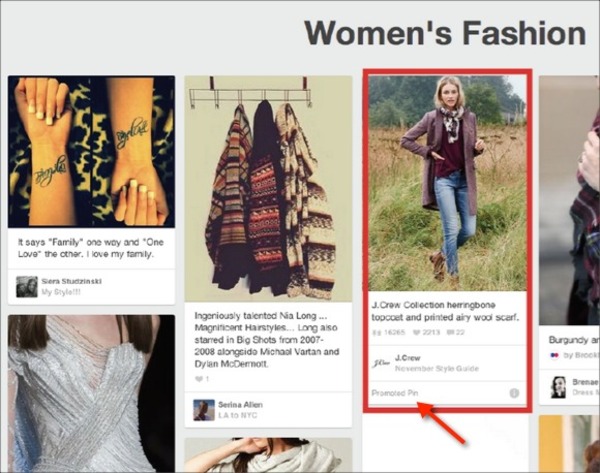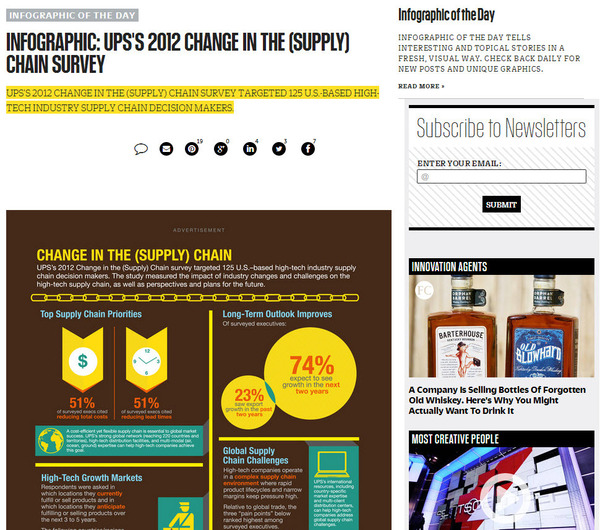You know the old saying “If it walks like a duck and talks like a duck, it’s a duck.” As it turns out, that’s not necessarily true. In the world of advertising, native ads look and function like the content around them, but they are definitely not merely editorial content.
Some native ads are a bit harder to detect than others. For example, this Forbes cover from last year:

This Forbes cover contains a native ad from Fidelity.
That big blue box in the upper right? That’s all native advertising. Let’s look at some more ads that you probably couldn’t tell were ads, and find out…
Why Native Ad Use is Growing
Business Insider estimates that spending on native advertising will reach $21 billion in 2018. Why the big spend? The simple answer is that native advertising works. Particularly effective on mobile, native ads outperform traditional banner ads by a considerable margin.
This may be in part due to the phenomenon known as banner blindness. TechTarget explains: “Banner blindness is the tendency of people to ignore banner ads on websites. Experts believe that banner blindness occurs because experienced Web users are in “search mode” and tend to ignore banner ads as irrelevant for their search.”
Is banner blindness a real thing? Think for a moment. Can you remember the last banner ad you really took the time to examine?

This Business Insider content is sponsored by UPS, and it says so, if you look closely.
Then, there is the information overload issue. Because of the overwhelming amount of information bombarding Internet users constantly, consumers have become adept at tuning out items that they consider to be irrelevant. Thus, they look for scannable items like headlines, lists, and navigation bars.
These behaviors make capturing the attention of the average consumer more challenging than ever. This is where native advertising comes in. Native ads eliminate the barrier of banner blindness and, because they appear as a natural part of the content which viewers are scanning, they are less likely to be missed or intentionally ignored.
A recent Sharethrough study reveals that native ads are highly effective. According to the study, consumers look at native ads 53 percent more frequently than display ads. What’s more, they are willing to share the ads with others. 32 percent of respondents said the native ad “is an ad I would share with a friend of family member” versus just 19 percent for display ads. As far as advertising outcomes go, that is gold.

This J Crew ad flows seamlessly into Pinterest’s layout.
But, Is Native Advertising Really Legit?
While it is hard to argue with the results achieved by native ads, there are some concerns about its widespread use. Due to the inherent nature of native ads, some opponents of the method say that native advertising is intentionally deceptive. Proponents, meanwhile, say that consumer behavior signals that consumers overwhelmingly prefer native advertising to more disruptive ads.
The Federal Trade Commission (FTC) issued guidance in 2015 to help native advertisers avoid practices which the FTC deems as being deceptive. According to the FTC, an advertisement or promotional message should not suggest or imply to consumers that it is anything other than an ad.
In cases where a native ad is clearly commercial in nature so that consumers are not likely to be misled, the FTC has no issue with native advertising. In cases where commercial intent is not so clear, the FTC requires that a specific, clear disclosure accompany the ad.

This UPS native ad blends into its environment subtly.
Do Native Ad Disclosures Really Work?
The question is, do native ad disclosures really signal consumers that what they are viewing is ad content? A recent University of Georgia Grady College of Journalism and Mass Communication study published in the Journal of Advertising reveals that fewer than 1 in 5 users recognize native ads as ads.

Ad or video content?
Bartosz W. Wojdynski, co-author of the study, notes: “”I think that many publishers and advertisers assume that just because they put a label on the content, consumers will automatically understand that the article they’re reading is a paid advertisement. These results show that’s not the case at all, although the design of the disclosure label can make a big difference … It’s going to be interesting to see how audience recognition of native ads changes over the next couple of years as the novelty of these ads wears off and people become more attuned to how disclosure practices are going to influence the way people respond.”
Native advertisers, then, must consider the possible issues that can arise with this form of advertising and weigh those issues against the potential rewards of native advertising. David Ervin, of Crowell and Moring LLP, notes in the Practical Law whitepaper “Native Advertising”:
“Native advertising, when done right, can be more effective than traditional advertising. When done poorly, it can cost a brand credibility and subject it to costly litigation and government enforcement.”
How to Ensure Your Native Ads Are Done Right
Considering all the potential outcomes of using native advertising, it becomes apparent that advertisers and marketers employing this strategy must toe the line to use native ads appropriately and effectively. Ervin points out that the best course of action is to maintain full transparency. He notes: “Native advertising is legal if a company is clear and transparent. Disclosures must be understandable to a reasonable consumer, regardless of who the targeted audience is.”
Hubspot’s “The Good and Evil of Native Advertising”explores this issue further and suggests ways in which advertisers can ensure their native ads will be received with enthusiasm rather than skepticism or even hostility. Here are the top two suggestions made:
- Produce engaging content. If a consumer is reading an article that is informative, interesting, and truthful, it is likely that consumer will not mind if it is also a sponsored ad.
- Do not create ads with the intent to deceive. For consumers who spot a deception right away, you lose all credibility. For consumers who do not, the fallout can be much worse when they catch on. Deception is bad, period.
The Takeaway
Content marketers who employ native advertising as part of their overall marketing strategy can reap significant rewards. Consumers appear to prefer native ads over more traditional advertising methods, and research indicates that native ads will continue to play a role in broadening the scope of brand marketing.
Producing engaging content and maintaining transparency by making the appropriate disclosure about the nature of your native ads will build trust with your target audience and help establish your brand more firmly in the minds of targeted consumers.
Still not sure about how to craft great content and use native advertising to your advantage? Check out our comprehensive guide to native advertising and contact us today to discuss your content needs.